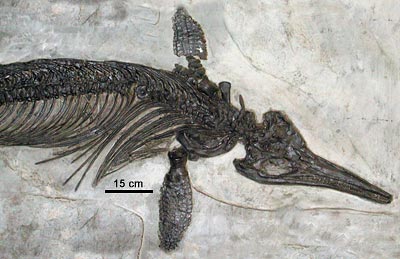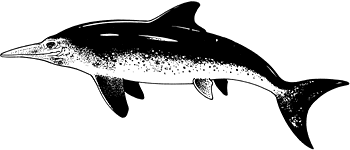
A specimen of the Jurassic icthyosaur Ichthyosaurus intermedius, found in Somerset County, England.
Ichthyosauria
The "fish lizards"
 A specimen of the Jurassic icthyosaur Ichthyosaurus intermedius, found in Somerset County, England. |
 Reconstruction of Ichthyosaurus. |
Ichthyosaurs were not dinosaurs, but represent a separate group of marine vertebrates. Because ichthyosaurs were so specialized and modified for life in the ocean, we don't really know which group of vertebrates were their closest relatives. They might have been an offshoot of the diapsids — the great vertebrate group that includes the dinosaurs and birds, the pterosaurs, the lizards and snakes, and many other vertebrates. On the other hand, some have suggested that the ichthyosaurs were descended from a distant relative of the turtles.
The first ichthyosaurs appeared in the Triassic. In the Jurassic, ichthyosaurs reached their highest diversity, and then began to decline. The last ichthyosaurs disappeared in the Cretaceous — some 25 million years before the last dinosaurs died out. Whatever caused the extinction of the dinosaurs did not cause the ichthyosaurs to die out.
Resources
|
||
Original content by Ben M. Waggoner, 9/1995; design changes and new images by Dave Smith, 11/2005; Ichthyosaurus intermedius photo by Sara Rieboldt, UCMP